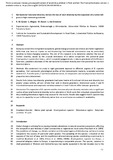Mostrar el registro sencillo del ítem
Soil bacterial functional diversity mirrors the loss of plant diversity by the expansion of a native tall-grass in high mountain grasslands
| dc.creator | Canals Tresserras, Rosa María | es_ES |
| dc.creator | Múgica Azpilicueta, Leire | es_ES |
| dc.creator | Durán Lázaro, María | es_ES |
| dc.creator | San Emeterio Garciandía, Leticia | es_ES |
| dc.date.accessioned | 2020-06-05T10:28:31Z | |
| dc.date.available | 2020-08-23T23:00:12Z | |
| dc.date.issued | 2019 | |
| dc.identifier.issn | 0032-079X | |
| dc.identifier.uri | https://hdl.handle.net/2454/37089 | |
| dc.description.abstract | Background and Aims: In highland ecosystems, global change processes are intense and foster vegetation shifts that may have an impact on soil functioning. Soil bacterial communities may be particularly sensitive to these changing scenarios. The aim of this research is to determine whether the loss of floristic diversity caused by the unusual dominance of a native component -the perennial grass Brachypodium rupestre (L.) Beauv., which is expanding aggressively in natural grasslands of the Western Pyrenees-, parallels a decrease of the soil bacterial functional diversity and their potential for nutrient transformations. Methods: We conducted the study in eight grasslands exposed to different degrees of B. rupestre spreading. Soil community physiological profiles of the heterotrophic bacteria, enzymatic activities related to C, P and N cycles, C and N microbial biomasses, N components and soil physical and chemical properties were determined. Results: Soils below low-diversity grasslands had lower bacterial functional richness and diversity but greater urease activity, pH and nitrate than soils in diverse grasslands. Ammonium pools, C and N microbial biomasses and enzymatic activities related to C and P did not differ between grasslands. Conclusions: The expansion of B. rupestre and the decrease of plant diversity coincided with a significant decline of bacterial functional diversity and an alteration of the N cycle. Not only plant composition but the prevailing disturbance regime may account for the results. Results also suggest that B. rupestre may rely on its capability to use N efficiently rather than on a soil bacteria-mediated N availability. | en |
| dc.description.sponsorship | The Spanish Ministry of Science and Innovation (CGL2011-29746) financed this research. M. Durán and L. Múgica got funding through an UPNA’s Research Staff Training Grant and L. San Emeterio by an UPNA’s Talent Recruitment Contract. | en |
| dc.format.extent | 20 p. | |
| dc.format.mimetype | application/pdf | en |
| dc.language.iso | eng | en |
| dc.publisher | Springer | en |
| dc.relation.ispartof | Plant and Soil, 2019, 445, 243-257 | en |
| dc.rights | © Springer Nature Switzerland AG 2019 | en |
| dc.subject | Grassland diversity | en |
| dc.subject | Native plant spread | en |
| dc.subject | Brachypodium rupestre | en |
| dc.subject | Disturbance regime | en |
| dc.subject | Enzymatic activities | en |
| dc.subject | N cycle | en |
| dc.title | Soil bacterial functional diversity mirrors the loss of plant diversity by the expansion of a native tall-grass in high mountain grasslands | en |
| dc.type | info:eu-repo/semantics/article | en |
| dc.type | Artículo / Artikulua | es |
| dc.contributor.department | Agronomía, Biotecnología y Alimentación | es_ES |
| dc.contributor.department | Agronomia, Bioteknologia eta Elikadura | eu |
| dc.contributor.department | Institute on Innovation and Sustainable Development in Food Chain - ISFOOD | es_ES |
| dc.rights.accessRights | info:eu-repo/semantics/openAccess | en |
| dc.rights.accessRights | Acceso abierto / Sarbide irekia | es |
| dc.embargo.terms | 2020-08-23 | |
| dc.identifier.doi | 10.1007/s11104-019-04281-w | |
| dc.relation.projectID | info:eu-repo/grantAgreement/MICINN//CGL2011-29746/ES/ | en |
| dc.relation.publisherversion | https://doi.org/10.1007/s11104-019-04281-w | |
| dc.type.version | info:eu-repo/semantics/acceptedVersion | en |
| dc.type.version | Versión aceptada / Onetsi den bertsioa | es |
| dc.contributor.funder | Universidad Pública de Navarra / Nafarroako Unibertsitate Publikoa | es |


